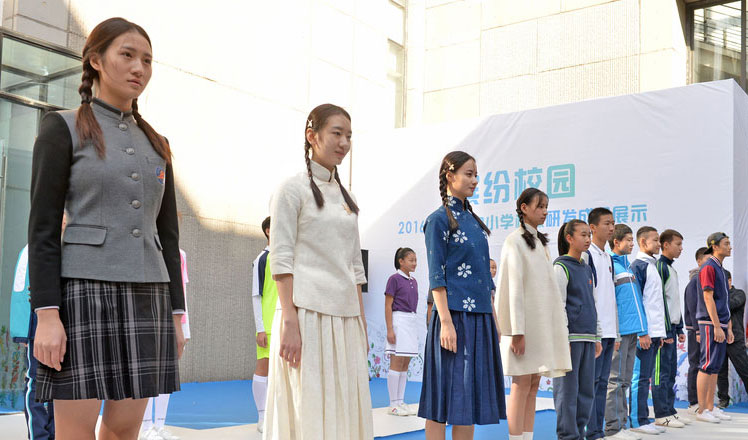Show celebrates Anthony Stones' ties with China
Updated: 2016-11-01 07:44
By Lin Qi(China Daily)
|
||||||||
 |
|
A young visitor walks among sculptures by Anthony Stones at the show Between China and West at the National Art Museum of China in Beijing. Jiang Dong / China Daily |
Feng Lili, the widow of UK-born sculptor Anthony Stones who died earlier this year at the age of 82, recalls her husband once telling her that he would rather people remember the statues he made more than his own face.
Months after his death in Beijing, an ongoing retrospective exhibition opened on Saturday at the capital's National Art Museum of China, reviewing his career as a sculptor and painter, as well as his close connections with China, where he lived for more than 15 years.
Titled Between China and West, the exhibition displays more than 200 sculptures and paintings. It shows the mark Stones left in continuing with the classical traditions of Western sculpture, and his creativity in painting and set design that gives viewers a glimpse of his broad vision of the art forms.
Feng donated a bulk of the exhibits to the museum.
"I was with him when he worked," Feng says. "He used various material for his sculptures and painted with both hands whether it was oil, watercolor or ink."
His experiences also reflected in his art.
"Nothing can be a better memory of him than this exhibition," she adds.
Wu Weishan, the museum director, says the exhibition traces two periods in Stones' artistic development - before 1984, when he first visited China, and after that when his exchanges with Chinese art circles increased, benefiting artists, especially the country's art students.
Born in England, Stones moved to New Zealand with his parents when he was 18. He moved back to Britain at age 49. While continuing to be an active artist, he presided over the Society of Portrait Sculptors in Winchester from 1999 to 2004. He was also a member of the Royal Society of Arts in London.
Wu says Stones' humanistic approach and classical style were inspired by ancient Greece and Rome. His works are also highly expressive, revealing an influence of French sculptor Auguste Rodin and other movements in modern sculpture.
Stones portrayed figures of critics, actors, writers, scientists and philosophers. He also sculpted the characters in theater plays of old masters such as William Shakespeare.
"He paid a tribute to those bracing for pure ideals," Wu says. "With his portraits of ordinary people like laborers, including the many he made in China, Stones communicated with the world in a peaceful manner."
Stones first came to China on an invitation from New Zealand-born writer Rewi Alley. The visit ignited his interest in Chinese society. He painted a lot of social scenes he saw in the streets.
He traveled frequently to China after the 1990s, giving lectures at universities across the country and researching Chinese culture.
In 2010, he collaborated with the Shenyang Normal University, in the northeastern Liaoning province, to establish an international sculpture academy named after him.
He gave lessons to graduate and postgraduate students, and organized international forums.
He didn't come to China to teach people how to replace Eastern art with Western art, says Feng. "He hoped his students in Shenyang would combine Western traditions of sculpture with Chinese history and culture, and create works of an Asian nature."
Li Tongtong, a teacher at the Stones International Sculpture Academy, says, "Stones often said in class that Michelangelo is watching over us. Now, I will tell my class that Stones is watching us, too."
If you go
9 am-5 pm, Mondays closed, through Nov 6. 1 Wusi Street, Dongcheng district, Beijing. 010-6400-1476.
- Father and son express gratitude by traveling to 200 Chinese cities
- Wife raises funds to search for missing sailor
- Two-child policy working, birthrate figures show
- China promotes transfer of farmland use right
- Hefty award offered for deciphering oracle bone characters
- China Daily brings you 'sixth plenums' in past 35 years
- EU, Canada sign landmark deals to enhance economic, political partnership
- Wife raises funds to search for missing sailor
- Clinton's edge ebbs after FBI's announcement of new email review: poll
- Asia American leaders discuss civic engagement
- World's disabled get new champion
- Clinton, Michelle Obama make first joint campaign appearance

 The World in photos: from Oct 24 to Oct 30
The World in photos: from Oct 24 to Oct 30
 Through the lens: The life of a kung fu master
Through the lens: The life of a kung fu master
 In pics: Top 10 Chinese cities in 2016
In pics: Top 10 Chinese cities in 2016
 A sprinkling of snow in China's northern part
A sprinkling of snow in China's northern part
 In pics: School uniforms get chic look
In pics: School uniforms get chic look
 China-Russia Internet Media Forum opens in Guangzhou
China-Russia Internet Media Forum opens in Guangzhou
 2016 Comedy Wildlife Photography Awards Finalists
2016 Comedy Wildlife Photography Awards Finalists
 NINED VR creates splash with virtual reality products
NINED VR creates splash with virtual reality products
Most Viewed
Editor's Picks

|

|

|

|

|

|
Today's Top News
'Zero Hunger Run' held in Rome
Trump outlines anti-terror plan, proposing extreme vetting for immigrants
Phelps puts spotlight on cupping
US launches airstrikes against IS targets in Libya's Sirte
Ministry slams US-Korean THAAD deployment
Two police officers shot at protest in Dallas
Abe's blame game reveals his policies failing to get results
Ending wildlife trafficking must be policy priority in Asia
US Weekly

|

|









